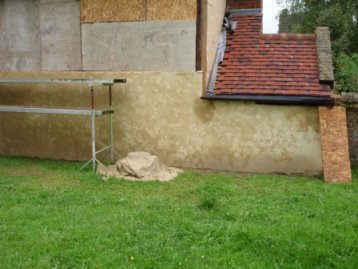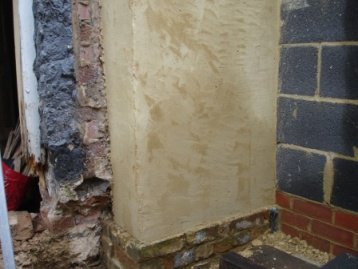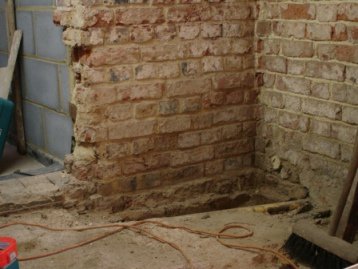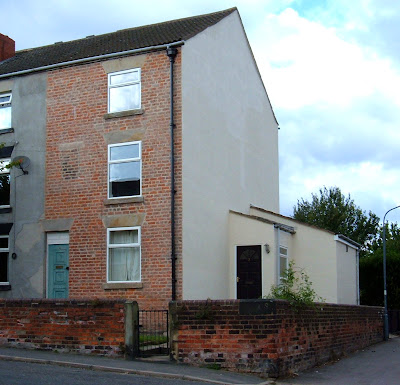Zebra
Member
- Messages
- 2,984
- Location
- St Albans, Hertfordshire
I'm wondering whether it might be the right time to consider more drastic measures with regard to damp, and would be grateful for any suggestions.
The original (17th/18th century?) solid brick walls of my living room are built of very soft porous brick, and there's a line of damp visible up to around 300mm. I've done all the right things so far: I've checked for faulty guttering, built a retaining wall to keep the soil away, or lowered external ground levels. I've taken the concrete slab away on the inside and dug a breathing trench which is still open. I've removed all impermeable coatings and repointed in lime. I've plastered the outside in lime.
This is the line of damp seen from the outside at the back where there is a retaining wall. It's still damp down in the gully, whereas above it is dry.

This is the line of damp seen from the outside at the front where I've lowered external ground levels.

And from the inside:

I can no longer accept that it is just taking time to dry out. The bricks are very soft and porous, so they absorb a lot of water but also dry very quickly. I absolutely saturated the wall when I plastered it, and higher up it has dried, lower down it hasn't. It gets wetter and drier with the weather. Either it's drawing the moisture up from the ground, or it's splashing against the wall, but with the same effect.
The damp is only on external walls. In areas where the house has been extended and so an original external wall with its feet directly in the soil is now internal, it's generally quite dry-ish. This still doesn't identify the cause though, because either the damp is spashing rainfall even though the ground is soft and absorbent, or it's rising up through the brick from the wetter ground outside.
So what now? After doing all this work on the house, spending so much of my time and tens of thousands of pounds, I can't really see myself just accepting having a living room with wet walls. Yes we're in a spell of wet weather but there will be wet spells again.
If injecting is out, electro-osmotic dpcs aren't considered to be up to much, what about physically cutting in a dpc? This won't help if it is splashing rainfall that's causing it.
Or what about allowing the moisture to rise up and escape outwards, but having a barrier internally? Would it be feasible to line the inside up to 500mm or so with a polythene membrane lapped into a floor membrane? What are people's experiences who've removed such a thing from an old house, does it go mouldy and nasty underneath the membrane? Or what if I were to paint the walls with a bitumen based liquid waterproofer, but over a new coat of lime mortar, so that the bitumen didn't damage the bricks? As long as the external surfaces were breathable, then any moisture which did rise up could escape outwards, and I would be dry.
I'd be grateful for any help, as I really can't see where to go next with this.
The original (17th/18th century?) solid brick walls of my living room are built of very soft porous brick, and there's a line of damp visible up to around 300mm. I've done all the right things so far: I've checked for faulty guttering, built a retaining wall to keep the soil away, or lowered external ground levels. I've taken the concrete slab away on the inside and dug a breathing trench which is still open. I've removed all impermeable coatings and repointed in lime. I've plastered the outside in lime.
This is the line of damp seen from the outside at the back where there is a retaining wall. It's still damp down in the gully, whereas above it is dry.

This is the line of damp seen from the outside at the front where I've lowered external ground levels.

And from the inside:

I can no longer accept that it is just taking time to dry out. The bricks are very soft and porous, so they absorb a lot of water but also dry very quickly. I absolutely saturated the wall when I plastered it, and higher up it has dried, lower down it hasn't. It gets wetter and drier with the weather. Either it's drawing the moisture up from the ground, or it's splashing against the wall, but with the same effect.
The damp is only on external walls. In areas where the house has been extended and so an original external wall with its feet directly in the soil is now internal, it's generally quite dry-ish. This still doesn't identify the cause though, because either the damp is spashing rainfall even though the ground is soft and absorbent, or it's rising up through the brick from the wetter ground outside.
So what now? After doing all this work on the house, spending so much of my time and tens of thousands of pounds, I can't really see myself just accepting having a living room with wet walls. Yes we're in a spell of wet weather but there will be wet spells again.
If injecting is out, electro-osmotic dpcs aren't considered to be up to much, what about physically cutting in a dpc? This won't help if it is splashing rainfall that's causing it.
Or what about allowing the moisture to rise up and escape outwards, but having a barrier internally? Would it be feasible to line the inside up to 500mm or so with a polythene membrane lapped into a floor membrane? What are people's experiences who've removed such a thing from an old house, does it go mouldy and nasty underneath the membrane? Or what if I were to paint the walls with a bitumen based liquid waterproofer, but over a new coat of lime mortar, so that the bitumen didn't damage the bricks? As long as the external surfaces were breathable, then any moisture which did rise up could escape outwards, and I would be dry.
I'd be grateful for any help, as I really can't see where to go next with this.


